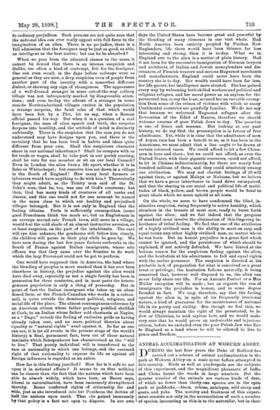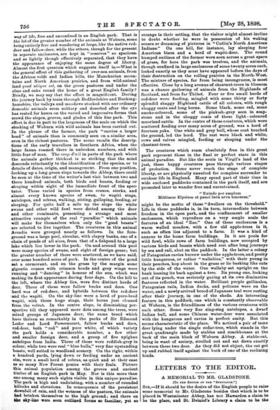ANIMAL ACCLIMATISATION AT WOBURN ABBEY.
DURING the last four years the Duke of Bedford has carried out a scheme of animal acclimatisation in the park at Woburn Abbey on a scale never before attempted in this country. Birds as well as quadrupeds are the subjects of this experiment, and the magnificent pheasants of India and China haunt the woods in large numbers. But the greater number of the animals are various kinds of deer, of which no fewer than thirty-one species are in the open park or paddocks,—bison, zebras, antelopes, wild sheep and goats, and yaks. The novelty and freshness of this experi- ment consists not only in the accumulation of such a number of species, interesting as this is to the naturalist, but in their way of life, free and unconfined in an English park. That is the lot of the greater number of the animals at Woburn, some being entirely free and wandering at large, like the native red.
deer and fallow-deer, while the others, though for the present in separate enclosures, are kept in "reserves" so spacious, and so lightly though effectively separated, that they have
the appearance of enjoying the same degree of liberty.
Almost the first question which suggests itself is,—What is the general effect of this gathering of over-sea animals, from the African veldt and Indian hills, the Manchurian moun- tains and North American prairies, and from wild-animal
land quod ubique eat, on the green pastures and under the
elms and oaks round the home of a great English family ?
Briefly, we may say that the effect is magnificent. During the journey back by train through Bedfordshire and Bucking-
hamshire, the valleys and meadows stocked with our ordinary domestic animals seem solitary and deserted after the eye lias rested for hours on the varied and impressive forms that crowd the slopes, groves, and glades of this fine park. This .effect is due in part to the largeness of the scale on which the stocking of Woburn with wild animals has been carried out. in the phrase of the farmer, the park "carries a larger head" of animals than is commonly seen on a similar area, even in the richest pastures. The scene recalls the descrip- tions of the early travellers in Southern Africa, when the large fauna roamed there in unbroken numbers, and with little fear of man. The coup d'ocil in parts of the park where the animals gather thickest is so striking that the mind descends reluctantly to the identification of the species, or to details of dates, origin, and management. From one position, looking up a long green slope towards the Abbey, there could be seen at the time of the writer's last visit between two and three hundred animals, both birds and beasts, feeding or sleeping within sight of the immediate front of the spec- tator. These varied in species from cranes, storks, and almost every known species of swan, to wapiti stags, antelopes, and zebras, walking, sitting, galloping, feeding, or sleeping. For quite half a mile up the slope the white swans and other wild fowl were dotted among the deer and other ruminants, presenting a strange and most attractive example of the real "paradise" which animals will make for themselves when only the "good beasts" are selected to live together. The creatures in this animal Arcadia were grouped nearly as follows. In the fore- ground was a large pool, circular, with clayey banks, one of a chain of ponds of all sizes, from that of a fishpond to a large lake which lies lower in the park. On and around this pool were many species of swans, and eight of foreign geese; but the greater number of these were scattered, as we have said, over some hundred acres of park. In the centre of the pond sat a cormorant, and on the grass by the margin some gigantic cranes with crimson heads and grey wings were running and " dancing " in honour of the sun, which was making its first appearance during four days. On the hill to the left, where the Abbey lies, were five distinct herds of deer. Three of these were fallow bucks and does. One herd was of red-deer, and hybrids between the red-deer and the wapiti. On the sky-line were a herd of pure-bred wapiti, with three huge stags, their horns just cleaned from the velvet. In the centre elope, in diminishing per- spective till they appeared mere dots among the trees, were mixed groups of Japanese deer, the same breed which have thriven so remarkably in the parks of Sir Edmund Loder and Lord Powerscourt, fallow bucks and does, red-deer, both "red" and pure white, of which variety the park holds a considerable number, a few other and smaller foreign deer, and a group of five nylghau antelopes from India. Three of these were reddish-grey in colour, while two were real "blue balls," very fine upstanding beasts, well suited to woodland scenery. On the right, within a hundred yards, lying down or feeding under an ancient elm, were a small herd of zebras, as quiet and at their ease as BO many New Forest ponies with their foals. Picture this animal population among the groves and ancient timber of an English park in May. Nor is this more than one among many such sights visible in this unique paradise. The park is high and undulating, with a number of rounded
hillocks and elevations. In consequence of the persistent
downfall of rain, and the wetness of the pasture, the animals had betaken themselves to the high ground.; and there on sky-lane were seen outlined forme so familiar, yet so
strange in their setting, that the visitor might almost incline to doubt whether he were in possession of his waking senses or dreaming of pictures in " Catlin's North American Indians." On one hill, for instance, lay sleeping four American bison and a herd of wapiti-deer. The round humped outlines of the former were seen across a great space of grass, for here the park was treeless, and the animals, though confined in large enclosures of some twenty acres each, looked exactly as they must have appeared before the days of their destruction on the rolling prairies in the North-West. The mixture of species, far from being incongruous, is most effective. Close by a long avenue of chestnut-trees in blossom was a chance gathering of animals from the Highlands of Scotland, and from far Thibet. Four or five small herds of red-deer were feeding, mingled with some thirty or forty splendid shaggy Highland cattle of all colours, with rough shaggy coats and long horns. Some black, some red, some smoke-coloured, some of the pinkish-grey seen in soap- stone and in the shaggy coats of these light - coloured moorland cattle. In the centre of these creatures, which were scattered feeding over many acres of ground, was a herd of fourteen yaks. One white and grey bull, whose coat touched the ground, led the herd. The rest were black and white, cows and calves mingled, feeding or sleeping under the chestnut-trees.
The creatures which roam absolutely free in this great park represent those in the final or perfect state in this animal paradise. But like the souls in Virgil's land of the just, these happy creatures pass through various stages of probation. Some never reach the stage of complete liberty, or are physically unsuited for complete surrender to outdoor life in England. Many spend part of their time in wide enclosed paddocks contained in the park itself, and are promoted later to wander free and unrestrained.
" Exhale per amplum Mittimur Elysium et pauci beta arva tenemus," might be the motto of these "dwellers on the threshold." Life in these paddocks is, in its turn, intermediate between freedom in the open park, and the confinement of smaller enclosures, which reproduce on a very ample scale the features of an ideal "Zoo." One of these enclosures is a warm walled meadow, with a few old apple-trees in it, such as often lies adjacent to a farm. It was a kind of annexe to the home farm buildings. In it are pools for wild fowl, while rows of farm buildings, now occupied by various birds and beasts which need rest after long journeys by sea and rail, abut on the paddock. In the latter a colony of Patagonian cavies burrow under the apple-trees, and pretty little kangaroos, or rather "wallabies," with their young in their pouches, hop about in the grass or lie basking like cats by the side of the water. One wallaby sat upright on the bank leaning its back against a tree. Its young one, looking out of its pouch, was seriously gazing at its own diminutive features reflected in the water. Brilliant purple gallinules, Patagonian rails, Indian ducks, and pelicans were on the water, and a newly arrived brood of Japanese teal were resting after their journey, in one of the sheds. An interesting feature in this paddock, one which is constantly observable at Woburn, is the friendliness of the various creatures with each other. Some very fine sing-sing antelopes, a dwarf Indian bull, and some Chinese water-deer were associated with the kangaroos and cavies in perfect amity. But this seems characteristic of the place. We noticed a pair of tame deer lying under the single cedar-tree, which stands in the great quadrangle made by stables and coachhouses at the back of the main block of Woburn Abbey. A stable-cat, being in want of society, strolled out and sat down exactly between these two deer. As they did not object, the cat got up and rubbed itself against the back of one of the reclining hinds.



































 Previous page
Previous page